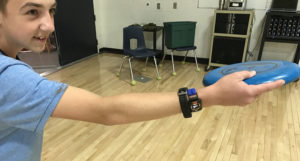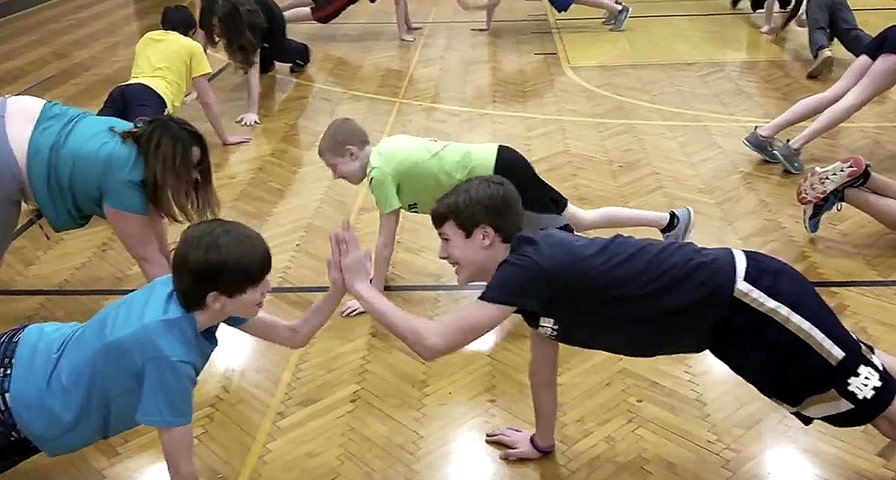Heart Rate Monitors Motivate Students to Absorb Key Lessons, Develop Lifelong Skills
Students using IHT ZONE wrist heart rate monitors during on-campus or online physical education classes learn how being active improves their overall health and well-being.
Through real-time feedback and an understanding that comes with consistent use, students are taking charge of their exercise and seeing the benefits. Using the heart rate monitors in class – either in person or online – keeps students in touch with their bodies. Students see:
- their heart rate in real-time, so they know if they are exercising in their target heart rate zone;
- immediate post-exercise feedback with details such as total time spent exercising and time spent in each heart rate zone; and
- a summary email with a heart rate graph that allows students to associate how they felt with how their body was actually working.
Here are examples of the positive impact programs using the IHT ZONE wrist heart rate monitor have made on students.
Getting Healthy Starts With Simply Becoming Active
Even students who often shy away from activity see the change, as one California teacher recalled.
“I explained that she didn’t have to run to get healthy,” the teacher said about a heavy student. “She just has to get moving. In January [2000], she really started working. She walked every day. It didn’t take long before we could really see a difference.”
The high school student kept her walking up even when her on-campus PE class had to close with the pandemic. She remained connected with her teacher online, and the regular check-ins showed the teacher how much the student had improved her health and her self-view.
“We connect over the computer now and she lets me know that she’s still walking every day and staying active,” the teacher said. “She hated PE [before] and was insecure about her body. Now, she’s seeing definite progress.”
Creating Self-Confidence Through Exercise
Sean Splawski, a STEAM teacher in Mableton, Ga., saw similar body image concerns from his students when a classroom exercise centered on taking selfies was met with anxiety. He uses the IHT ZONE in his lab with his students to focus on the importance of staying active and exercising at a level that makes changes that students can both see and feel.
“We want the students to be confident about themselves,” he said. “We focus on how the monitors can help change your body image through exercise.”
Exercise doesn’t have to mean running a mile in a certain time or sprinting a certain number of laps around a track. Splawski encourages students to start small – to walk before they run, so to speak. Set a small goal, and when you meet it, set another goal for the next day. But stay active, he said.
“Even if it’s just taking a walk, we really just need them to understand how important exercise is,” he said. “If you can motivate one student to start exercising, every other kid will see it and we’ll begin changing for the good.”
Motivating Students to Give Their Best Effort
Assessing students as they completed PE assignments used to be about what teachers saw from their students. The student running the most laps the fastest must be working hard while the student walking in the back of the group must not be working at all. Perhaps, but not always, as Rock River (Wisc.) Intermediate School PE teacher Jackie Clark learned.
“Many times some PE teachers assume that if a kid is not running they are not working hard,” Clark said. “In reality, an unfit child can be walking and still be in their target heart rate zone.”
Her PE class included a member of the school’s cross country team along with students who struggle to run very short distances. During one of her first classes using the IHT ZONES, she saw a stark difference.
 “The biggest ah-ha moment was when one of my cross country runners downloaded their heart rate monitor one of those first days and was in their zone for only a couple minutes while a fellow student who was not that fit, was in their target heart rate zone 27 minutes and surpassed their goal of 21 minutes,” she said.
“The biggest ah-ha moment was when one of my cross country runners downloaded their heart rate monitor one of those first days and was in their zone for only a couple minutes while a fellow student who was not that fit, was in their target heart rate zone 27 minutes and surpassed their goal of 21 minutes,” she said.
The data set Clark up to have conversations with each student. For the less fit student, the data provided a sense of accomplishment that would motivate that student to keep working to improve. For the cross country runner, it became an opportunity to show what actual hard exercise feels like.
“We had a great conversation focused on the fact that fitness is not one-size-fits-all,” Clark said. “I challenged him to get into his target zone for the next period. That was all the motivation he needed to prove to himself that he could get in that zone.”
It’s Okay to ‘Push Toward New Limits’
When he started using the IHT ZONE monitors with his Crestview School of Inquiry elementary students, Chris Amundson saw one student excel during assessments but not exert much energy in other PE activities.
“She just is someone who likes to hide and make it look like she’s being active without pushing too hard because she doesn’t want to seem like an overachiever,” he said.
That changed when she started wearing the IHT ZONE. Knowing she would be assessed based on the time she spent in target heart rate zones, she began pushing herself to meet – and exceed goals.
“She has a real reason to push herself,” Amundson said. “(After we’d been using them for a bit, she told me, ‘if you had talked to me three months ago, there’s no way I would have hit my goals because I was just trying to stay below everyone else.’ Now, she’s leading the pack. She’s pushing hard, she’s sweating. She’s excited about what we’re doing.”
And she’s excited about what the increased effort has done for her overall wellness.
“She’s going all out because she’s motivated and she can see how active she is and how her body is reacting to all of this exercise,” he said. “It becomes them learning that it’s great to push yourself to new limits.”
Reaching the Students Who Need It Most
Portage Central (Mich.) Middle School PE teacher John Dunlop recalls one of the first breakthrough moments he saw with a student benefitting from wearing a heart rate monitor during class. Like Clark, his class included students who loved exercise and students who didn’t.
“Those are the kids you worry about,” he said. “It’s the kids who this doesn’t come as easy for who need to experience success and get some feedback as to what they are doing.”
Dunlop’s seen his middle school students go on to become high school or even college athletes. He’s also taught students who were only in class because they are required to be there, as he recalled in 2017.
“He hates PE, he doesn’t really like school and he struggles a little academically,” Dunlop said.
But something clicked for the student when Dunlop brought out the heart rate monitor. The teacher explained how the IHT ZONE assesses each student according to their own heart rate and ability.
“When we started using the heart rate monitors, I saw a complete change in his attitude,” Dunlop said.
The student fully participated in class that day. When he returned his heart rate monitor and saw his session report, he saw that he had met his daily goal for minutes of moderate-to-vigorous physical activity.
“He said, ‘hey, I did pretty good today,’” Dunlop said. “I don’t know if that kid has ever experienced success in PE until this year.”
Building Skills to Create Real-Life Successes
It’s one thing for students to meet their goals under the helpful eyes of their teachers with heart rate monitors provided by school. For most teachers, the ultimate goal remains preparing students to lead healthy, active lives when they graduate high school or college and enter the “real world.”
“They’ll eventually be 18 years old and graduating from high school and hopefully progressing through college and out into the real world,” Lindsay Belville, PE teacher at Bridge Creek (S.C.) Elementary School said. “They’ll still need to know this.”
The IHT ZONE is a staple of the student wellness program at IDEA Public Schools, where 59 campuses recently earned healthy schools designation from the Alliance for a Healthier Generation. Students use the ZONES every time they come to PE class, and teachers are instilling skills and habits they believe will serve them into adulthood.
“The commitment that physical activity is a primary factor in how we’re going to get our kids to be able to grow to success as they head into the real world,” IDEA Director of Athletics and PE Eren Kirksey said.
Seeking information about IHT’s Remote Learning program?




